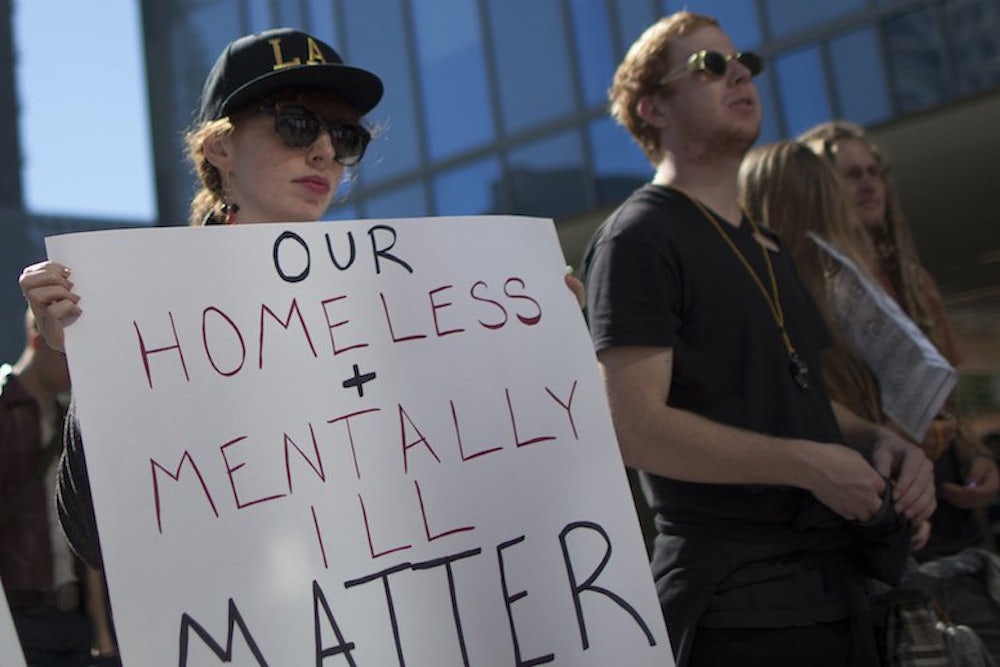Like the recent shooting in Pasco, Washington, the latest police killing of an unarmed man was captured on video in broad daylight and in front of several witnesses—this time, on Los Angeles' Skid Row. The victim was black, and homeless: The Los Angeles Times reports that he went by “Africa” and sometimes "Cameroon," his home country. Witnesses said he was relatively new to the area and had a history of mental illness.
City officials promised a full investigation, but the odds of meaningful accountability are long—not only because the homeless are already at a disadvantage, but because the mere invocation of “Drop the gun” by police is likely to shield them from liability. Courts give great deference to police officers: The law allows for reasonable use of force under the circumstances, and deadly force has been found to be reasonable when an officer believes his life to be in danger. Does a homeless man with a potential history of mental illness really pose a life threat to six armed officers?
The incident happened on well-policed Skid Row, an area in downtown Los Angeles known for rampant homelessness. The officers were reportedly part of the Safer City Initiative, an effort to curb petty offenses by dedicating more police manpower to high-priority areas. As fate would have it, the program, which is in the mold of New York City’s “broken windows” approach, was championed by NYC Police Commissioner William Bratton when he was the chief there.
Bratton himself once called Skid Row “the worst situation in America,” and Rev. Andy Bales, the head of Union Rescue Mission, which serves Skid Row residents, named it “the biggest man-made disaster in the United States.” According to a 2013 report by the U.S. Department of Housing and Urban Development, Los Angeles is only second to New York City in terms of homeless population: About 54,000, or nine percent of the national total. Julian Castro, the federal housing secretary, visited the city in January for its biennial homeless count and to pledge housing solutions.
Fixes large and small have been in the works for decades, and the crackdowns continue. A pair of lawsuits have challenged city policies targeting the Skid Row homeless, including the destruction of property and criminalization of street living. LAPD misconduct is not, of course, limited to Skid Row. Until 2013, the department was under DOJ oversight for more than a decade, owing to widespread corruption and civil rights violations. In the wake of Ferguson, a Los Angeles Times review of homicides involving the LAPD found the rate of blacks killed was grossly disproportionate. The paper estimated that 32 percent of police victims are black, but the city of Los Angeles is only less than 10 percent black. But it’s hard to say if the LAPD is back to its pre-federal supervision days, which ended in 2013 after a federal judge lifted a 12-year-old consent decree that forced the department to undergo strict reforms.
Those demons are distinct and yet deeply related to Skid Row. Reacting to Africa’s shooting, criminal defense lawyer Scott Greenfield, who blogs about criminal justice issues, wrote a stark assessment of the killing: “No one is more objectified than society’s rejects, the worthless breathing bodies that make streets unpleasant. Only when we see a video of police killing a homeless guy do we realize that he’s not just a thing, but a person. Only then do we give a damn about him.”
A pattern is emerging: With every new video or victim’s story that goes viral, a different ill gets a short time in the spotlight—broken windows, public housing, mental illness, illegal immigration, homelessness. The police killings of Michael Brown and Eric Garner sparked protests not just in Ferguson and New York City, but across the United States—they were a capstone to a national conversation around race, policing, and inequality that had been simmering since the summer. But there has been no such response to the killing of Antonio Zambrano-Montes in Pasco, and it's hard to imagine that Africa's death—despite the tens of millions who have watched it on Facebook—will inspire mass demonstrations.
That may be because Africa has no family or community to take up his cause. Or because homelessness, like other invisible struggles, doesn’t quite resonate with us because we have never shared personal space with them. And if we have, we wince or change subway cars or bring our hands to our noses. Or it may be that we're already becoming inured to viral videos of cops killing unarmed blacks and Latinos. Sharing them on social media with hashtags is as far as our activism takes us.
